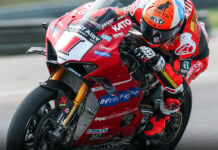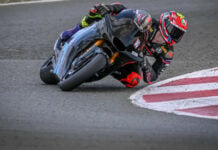FIRST PERSON/OPINION By David Swarts In January, AMA Pro Racing announced that it will implement a hardware price cap of $18,000 per motorcycle for engine control and data acquisition electronics in the Superbike class, beginning with the 2013 season and continuing through 2015. The only previous restriction required that hardware be homologated and approved for use by AMA Pro Racing Technical Director Of Competition Al Ludington. But teams say that hardware cost is not the biggest concern, with the cost of buying or developing software and hiring qualified technicians to run the complicated systems making up the bulk of the expense. Yoshimura Racing admits to spending $300,000 per season on electronics hardware, software, development, testing and personnel for its two-rider effort in AMA Pro Superbike. Yoshimura, like Monster Energy Graves Yamaha, uses Magneti Marelli Marvel 4 systems and employs multiple technicians to run the systems. Jordan Suzuki and National Guard Suzuki use Pectel systems run by multiple technicians, while KTM uses Magneti Marelli SRT systems run by a technician who flies in from Italy for each AMA Pro Superbike round. Most of the other teams use much-less-expensive, much-less-capable, readily available race-kit black boxes (a.k.a. Engine Control Units, or ECUs) that sell for less than $3500 including wiring harness. Examples include Suzuki’s EM Pro system for GSX-R1000s or Yamaha’s YEC system for YZF-R1s. The BMW kit box for the S1000RR sells for about $4000 and plugs into the standard wiring harness. The Kawasaki kit box and wiring harness for the ZX-10R sell for less than $1500. A KTM kit box and setting tool for the RC8 R sells for under $1200. An EBR kit box for the 1190RS sells for $750. Meetings held as recently as last month between AMA Pro Racing officials and team representatives have revealed a deep divide in the paddock, with the majority of teams wanting to switch to kit boxes across the board, with a few notable holdouts. AMA Pro officials have openly admitted that they established the 2013-2015 rule now on the books based on one winning team’s threat to quit the series if it wasn’t allowed to continue using the Marvel 4 system currently fitted to its racebikes. To check where the top-10 players in the AMA Pro Superbike class stand on electronics rules, we posed the following questions: 1. What should the AMA Pro Superbike electronic rules be for 2013-2015 and why? 2. What do you say to someone who claims they need a year or more notice to get ready for any rule change, including switching from the currently allowed advanced electronics to kit boxes? Part Two: Pete Mauhar, Team Manager Michael Jordan Motorsports Suzuki National Guard Suzuki Riders, Ben Bostrom, Roger Hayden Electronics, Pectel “What I would like to see would be a kit box with some sort of fuel management device like a Bazzaz unit and data acquisition. So for example you could have a data-logging dash to look at front and rear ride heights and strokes, things like that. “I always think you can manipulate that price cap, but I think the biggest problem really for most of the Superbike teams is not so much the cost of the electronics but the cost to run the electronics. It’s the data guy you need that understands the system and can run it. It’s the testing you need to do to map everything and get it right. If it was just plug-and-play it wouldn’t be so much of an issue, but we know that that’s not the case now. It takes many tests and many testing dollars and dollars on testing personnel to get the thing right.” What about people who say they need a year’s notice on rule changes? “For that kind of a change I don’t think that you do. A kit box seems like you can put it on and run without much work. I understand those that say it’s Superbike and we need all this really cool stuff and technology and that’s true, but in this economy it’s not only the money that you have to spend on your systems and your back-ups but also for the person to run it, the time to test it and all that that raises the costs. “And if you see how it goes this year, the guys leading all of the time and running away with it have these high-dollar electronics system. So everyone else behind them, whether it’s true or not, will think that you need that system in order to compete. “Let’s say a team wants to move from DSB into Superbike, the costs are more because of the wheels, brakes and the other things. Then you throw the electronics into the picture and it’s a lot more money, a lot more development time and we don’t have the people who are trained in that. So it’s almost an unobtainable place to be. We might as well stay in Daytona SportBike. One of the reasons our grid in Superbike is so small, because there’s qualified riders and riders that want to be there, but there’s no rides, there’s no teams. There are people who want to go into Superbike and look at the current state of it and come to the conclusion, right or wrong, they come to the conclusion that they need high-dollar electronics and all that come with it, and they may just decide not to. “I would love to have open engine rules and be able to do rods and pistons and swingarms and forks and all kind of cool stuff, but can anyone really afford to do that these days? Where we’re at these days and the cost of racing and what you’re able to get from manufacturers and sponsors, it’s tough to go racing.” To be continued…
Superbike Electronics: AMA Pro Team Managers Talk About What Rules Should Be For 2013 And Beyond, Part Two
Superbike Electronics: AMA Pro Team Managers Talk About What Rules Should Be For 2013 And Beyond, Part Two
© 2012, Roadracing World Publishing, Inc.






